#and their tails are much larger relative to their bodies
Explore tagged Tumblr posts
Text
me worldbuilding: there are some little bunny-people that are well known for their lovely gardens.
they were literally made for war and even though it has been centuries since they were under the thumb of the evil wizard that created them, their society still reflects this, being highly stratified and highly conformist.
occasionally, some jackass will think that the sweet lil bunbuns will be easily bullied off their valuable farmlands, and gets his ass kicked to a pulp for trying.
#they've got forward facing eyes with slit pupils like cats#and their tails are much larger relative to their bodies#than actual rabbits#bc they use them to counter-balance#so they walk bipedally#they do have a very high birthrate#but with extremely high infant mortality to match#their laws consider children too young to walk#as property and not people
3 notes
·
View notes
Text

Metriorhynchids were a group of fully marine crocodyliforms known from the mid-Jurassic to the early Cretaceous of Europe and the Americas. They were the most aquatic-adapted of all known archosaurs, with streamlined bodies, smooth scaleless skin, small front flippers, larger hind flippers, and shark-like tail flukes. They may also have been endothermic, and might even have given live birth at sea rather than laying eggs.
Rhacheosaurus gracilis here was a metriorhynchid that lived in warm shallow waters around what is now Germany during the late Jurassic, about 150 million years ago. Around 1.5m long (~5'), its long narrow snout lined with delicate pointed teeth suggests it fed on small soft-bodied prey, a niche partitioning specialization that allowed it to coexist with several other metriorhynchid species in the same habitat.
Unlike most other marine reptiles metriorhynchids didn't have particularly retracted nostrils, which may have had a limiting effect on their efficiency as sustained swimmers since higher-set nostrils make it much easier to breathe without having to lift the whole head above the surface. The lack of such an adaptation in this group may be due to their ancestors having a single nasal opening formed entirely within the premaxilla bones at the tip of the snout, uniquely limiting how far it could easily shift backwards – other marine reptiles had nostrils bound by the edges of multiple different bones, giving them much more flexibility to move the openings around.
(By the early Cretaceous a close relative of Rhacheosaurus did actually evolve nostrils bound by both the premaxilla and the maxilla, and appeared to have started more significant retraction, but unfortunately this only happened shortly before the group's extinction.)
Metriorhynchids also had well-developed salt glands in front of their eyes, but the large sinuses that accommodated these glands may have made their skulls ill-suited to deep diving, being more susceptible to serious damage from pressure changes and restricting their swimming to near-surface waters only.
Preserved skin impressions in some metriorhynchid fossils show several unusual "irregularities", including curl shapes, small bumps, and cratering. It's unknown what exactly caused these marks, but they may represent scarring from external parasites such as lampreys and barnacles.
———
NixIllustration.com | Tumblr | Patreon
References:
Andrade, Marco BD, and Mark T. Young. "High diversity of thalattosuchian crocodylians and the niche partition in the Solnhofen Sea." 56th Symposium of Vertebrate Palaeontology and Comparative Anatomy, 2008. https://svpca.org/years/2008_dublin/abstracts.pdf#page=14
Séon, Nicolas, et al. "Thermophysiologies of Jurassic marine crocodylomorphs inferred from the oxygen isotope composition of their tooth apatite." Philosophical Transactions of the Royal Society B 375.1793 (2020): 20190139. https://doi.org/10.1098/rstb.2019.0139
Spindler, Frederik. "Live Birth in a Jurassic Marine Crocodile." Abstracts of the 90th Annual Meeting of the Paläontologische Gesellschaft, 2019. https://www.palaeontologie.geowissenschaften.uni-muenchen.de/pdfs/palges2019_abstracts.pdf#page=141
Spindler, Frederik, et al. "The integument of pelagic crocodylomorphs (Thalattosuchia: Metriorhynchidae)" Palaeontologia Electronica 24.2 (2021): a25. https://doi.org/10.26879/1099
Young, Mark T., et al. "Convergent evolution and possible constraint in the posterodorsal retraction of the external nares in pelagic crocodylomorphs." Zoological Journal of the Linnean Society 189.2 (2020): 494-520. https://doi.org/10.1093/zoolinnean/zlaa021
Young, Mark T., et al. "Skull sinuses precluded extinct crocodile relatives from cetacean-style deep diving as they transitioned from land to sea." Royal Society Open Science 11.10 (2024): 241272. https://doi.org/10.1098/rsos.241272
Wikipedia contributors. “Metriorhynchidae” Wikipedia, 12 Nov. 2024, https://en.wikipedia.org/wiki/Metriorhynchidae
Wikipedia contributors. “Rhacheosaurus” Wikipedia, 02 Dec. 2024, https://en.wikipedia.org/wiki/Rhacheosaurus
#science illustration#paleontology#paleoart#palaeoblr#rhacheosaurus#metriorhynchidae#thalattosuchia#crocodyliformes#crocodylomorpha#pseudosuchia#archosaur#art#marine reptile#lamprey#barnacle#parasite
444 notes
·
View notes
Text
Asiatyrannus xui Zheng et al., 2024 (new genus and species)

(Skull of Asiatyrannus xui, from Zheng et al., 2024)
Meaning of name: Asiatyrannus = Asia tyrant [in Latin]; xui = for Xu Xing [Chinese paleontologist]
Age: Late Cretaceous (Maastrichtian)
Where found: Nanxiong Formation, Jiangxi, China
How much is known: Partial skeleton of one individual, including a nearly complete skull, some hindlimb bones, and several tail vertebrae.
Notes: Asiatyrannus was a tyrannosaurid theropod, making it a fairly close relative to Tyrannosaurus. It is the second tyrannosaurid to be named from the Nanxiong Formation, the first being the much larger and longer-snouted Qianzhousaurus. Indeed, Asiatyrannus was small for a tyrannosaurid, estimated as having been 3.5–4 m long in total body length.
Although other supposed "small" tyrannosaurids had previously been named, these turned out to have been based on immature specimens. Based on microscopic examination of its bone structure, the describers of Asiatyrannus suggest that the type specimen had not finished growing when it died, but its growth had slowed down such that it was close to reaching its full size. It is estimated to have been at least 13 years old at the time of its death.
Reference: Zheng, W., X. Jin, J. Xie, and T. Du. 2024. The first deep-snouted tyrannosaur from Upper Cretaceous Ganzhou City of southeastern China. Scientific Reports 14: 16276. doi: 10.1038/s41598-024-66278-5
199 notes
·
View notes
Text

More Official reference for the Chenest. They have hands now!! Written transcription + extra information under the cut cause this is a lot to put in alt text.
Chenest, aka Land Seals, Gecko Horses, or Deer Fish, are horse sized oviparous hypocarnivores that sustain themselves primarily on swamp vegetation and mouth-sized creatures.
They have a quartered septum with two channels being for air and two for smell specifically. The nostrils and scent glands can be closed independently of one another, allowing the Chenesht to smell without breathing and breathe without smelling. Additionally, their six barbels serve as electrical and touch sensory organs that make up for the relatively poor eyesight.
Their eyes are fairly nearsighted but have a wide field of view and focus primarily on detecting movement in their surroundings rather than clear images. While swimming, diving, or foraging underwater, a thin nictitating membrane covers their eyes to keep them protected from harmful irritants.
Chenesht ears, similar to their nasal cavities, can Seal while underwater to prevent irritation or water from getting stuck.
Chenest hands have four fingers both front and back with retractable claws, the center two being less curved than the outer two. The bottoms of their hands have two main Gecko like pads, a secondary pad, and a pad per finger, with their feet only having one main pad. These pads allow them to adhere to their slippery swamp environment without tripping and eating shit on the ground. In addition to claws, the 'Cob' sex of Chenesht posess Spurs on their ankles used for fighting.
Their small tails generally serve no purpose aside from keeping small fly-esque creatures away from their rears, preventing crop infection, as well as being a small fat reserve. It's theorized that Chenesht ancestors once had much larger tails that shrunk over time in favor of a more terrestrial lifestyle.
Chenesht teeth are covered in a thick layer of keratin called Rhamphotheca which regularly grows and sheds to protect the inner teeth from from the harsh, acidic flesh of the meat their diet used to be primarily made of, as well as the irritating plant matter they regularly consume. Their dual uvulas allow them to produce thick, gummy saliva that keeps the cnidarian-typical barbs of the helium jellies (a common predator), nettle like thorn structures in most edible plants, and other soft tissue irritants from hurting their mouths as they chew. The Rhampotheca is black in color and leads to the appearance of ink stained or charcoal black teeth.
The blue blood of the Chenesht is due to Hemocyanins being the primary color receptor in their blood rather than Hemoglobins and is bolstered by a copper-rich diet.
The "hump" on their back is the attachment point for immensely powerful forelimb muscles. A Chenesht's arms are one of the strongest limbs on their body, second only to their powerful legs.
Chenesht are a bisex species, the two sexes being Reeve and Cob. Reeves are larger and duller, and Cobs are smaller and brighter. Cobs also possess a unique inflatable throat pouch used for amplifying calls and mating display. In their current culture, the pouch is often tattooed or otherwise decorated to enhance beauty and also because it's fun. Additionally, Cobs sometimes have patches on their body that flush with blood to take on a bright blue color. While mostly for display purposes, these patches will also flush if the Cob is exhausted or excited.
No I am not getting into Chenesht reproduction here. They work like seahorses. Sort of. That's all you'll get.
#arte#worldbuilding#setting: sacred estuaries#SE chenesht#specbio#speculative biology#original alien character#original alien species
88 notes
·
View notes
Text
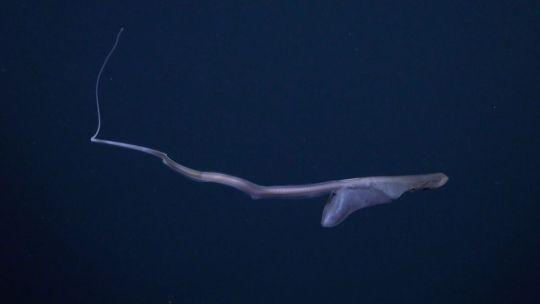
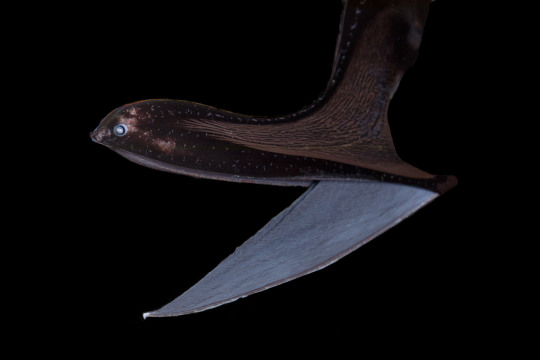
youtube
The Can-do Pelican Eel
The pelican eel, also known as the gulper eel (Eurypharynx pelecanoides), are the only known species of eel in the family Eurypharyngidae. They are found exclusively in the deeper parts of the water column, from depths of 500 up to to 3,000 m (1,600 to 9,800 ft), but are distributed throughout all the world's oceans.
The gulper eel is perhaps most famous for its unique body shape. Like many deep-sea fish, this species is highly adapted to its environment; maximum energy efficiency is the highest priority. To that end, the pelican eel has a large head, and a jaw estimated to be quarter of the total length of its body. The jaw is loosely hinged, meaning that gulper eels can open their mouths extremely wide. The rest of the eel, in contrast, is quite slender and long, about 0.75 m (2.5 ft) in length on average. Most individuals are black--so black, in fact, that they only reflect 0.5% of light; perfect for hiding from potential predators.
Although they look skinny, E. pelecanoides can expand their stomachs to hold prey much larger than themselves. Their primary prey consists of crustaceans and cephalopods, though they may feed opportunistically on other fish. Because it is so well camouflaged, it uses bioluminescent organs on the tip of its tail to attract prey. Gulper eels themselves are preyed upon by lancetfish and other larger deep-sea fish. To deter predators, they will gulp down a large amount of water; this stretches the loose skin around their head and throat, and inflates them to several times their usual size.
Because of their remote location, the breeding habits of gulper eels are relatively unknown. However, it is believed that smell plays a large part in attracting a mate, as pelican eels have highly developed olfactory organs. Like other eels, they're born as tiny, transparent larvae in a state known as the leptocephalus stage. At this stage, they do not have any red blood cells. Researchers aren't sure how long it takes gulper eels to become fully mature, or how long they live, but many believe that adults die shortly after mating.
Conservation status: The population size of E. pelecanoides has not been assessed, and thus the IUCN has not made a determination on its status. The greatest threat for this species is deep-sea trawling, which frequently brings up gulper eels as by-catch.
Photos/Video
Paul Caiger
Schmidt Ocean Institute
EV Nautilus Team (I highly recommend checking out their 2023 highlights reel!)
#pelican eel#gulper eel#Anguilliformes#Eurypharyngidae#eels#ray-finned fish#bony fish#fish#pelagic fauna#open ocean fauna#pelagic fish#deep sea#deep sea fish#Atlantic Ocean#Pacific Ocean#Indian Ocean#Arctic Ocean#Southern Ocean#animal facts#biology#zoology#ecology#marine fauna#marine fish#Youtube
177 notes
·
View notes
Text
Wet Beast Wednesday: bluegill
This series goes all over the world; from the tropics to the poles to the deep sea. After all that, it can be nice to go home. For this Wet Beast Wednesday I'm going back to my spawnpoint of Illinois and discussing the state fish: the bluegill.

(Image: a bluegill underwater. It is a round fish flattened on the sides. It is green on the top ans fades to yellow on the sides. The underside of the chin is bright blue and behind the head is a bright orange patch. End ID)
Lepomis macrochirus is the most popular and famous of genus Lepomis, known as the sunfish or true sunfish (not to be confused with ocean sunfish). These fish are native to freshwater lakes, streams, wetlands, and rivers of North America and all share a fleshy ear flap extending from the operculum and are usually quite colorful. Bluegills are large for sunfish, which isn't saying much. Adults can reach and average of between 10 and 30 cm (4-12 in) and the largest bluegill on record reached a whopping 41 cm (16 cm) and was weighed in at 4 lbs 12 ox (2.2 kg). Bluegills and flattened and deep bodies with fused dorsal fins and spines in both the dorsal and anal fins that help prevent predation. The fish are brightly colored, but coloration varies widely based on size, diet, time of year, location, and many other factors. Because of this, two bluegill can look like completely different fish. Their bodies can range from dark green to orange, darkest on the top, and they usually have green faces with blue markings on the chin and bottom of the face that give them their common name. The "breast" region just below and behind the head ranges from yellow to orange and is usually a bright orange in mature males. A key feature is that the ear flap is black. Bluegills usually grow more brightly colored during mating season and less colorful other times of the year. There is a series of vertical stripes going down the side of the body that can quickly be darkened as a threat display.
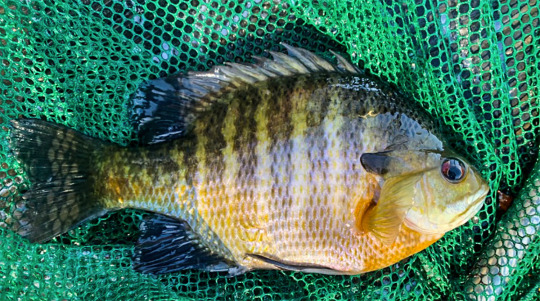
(Image: a bluegill in a net with its stripes in full display. End ID)
Bluegill are skilled swimmers thanks to the shape and flexibility of their fins and the amount of fine control they have over them. This lets the fish maneuver gracefully through obstacles and confined spaces that other fish would struggle in and turn while not having to move forward. Bluegills are also one of a relatively few fish that are skilled at swimming backwards. This requires very different fin motion than swimming forwards. When swimming forwards, bluegills use their tail fin to provide thrust with the other fins helping with steering as is typical for fish. While swimming backwards, the dorsal and anal fins provide thrust while the pectoral fins are moved in a rowing motion to provide steering. Bluegills are also fast swimmers, their slender bodies allowing them to cut through the water at high speeds. Bluegills are also often used as an example when explaining the c-start escape response. This is a behavior found in tons of fish used to escape from danger. When the fish senses danger, a group of specialized neurons called Mauthner cells activate and control the escape response. The fish bends its body into a C shape. This shape allows for maximum thrust when it rapidly straightens its body out again for a speedy getaway. The c-start escape response is heavily customizable, allowing the fish to shoot off at nearly any angle it needs.
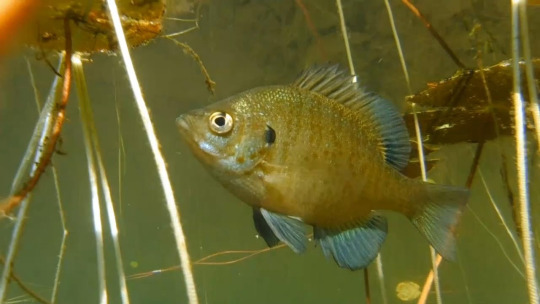
(Image: a young bluegill swimming amongst lilypads. It is not as round as the larger fish and its colors are more muted. End ID)
Bluegills are found in freshwater systems east of the Rocky Mountains (so most of North America) but they have been introduced west of the Rockies and to other parts of the world. They are very adaptable fish that can live in a wide variety of environments. It is probably easier to list bodies of water in North America that don't have bluegill than the other way around. They prefer to live in areas with cover, live brush, aquatic plants, and shady spots. Bluegill are diurnal predators that subsist on aquatic invertebrates like insect and crayfish larvae and worms, along with the occasional smaller fish. In times of famine, they will eat aquatic plants and algae or turn to cannibalism. Like many fish, bluegill feed through suction and they need to get within under 2 centimeters of they prey for the suction to be effective. Bluegills are also prey to larger predatory fish, turtles, birds, raccoons, and otters. Bluegill are mostly active in the morning and evening and will often move between feeding grounds and shelter during the day. They are reported to be aggressive to each other and other fish. Sighs of aggression include darkening their stripes, flaring their ear flaps, and biting.
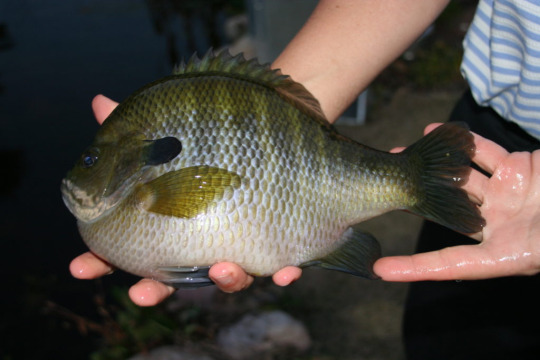
(Image: someone holding a very fat bluegill. End ID)
Bluegills mate in the summer between May and August. Males will build nests in rocky or sandy bottoms by clearing away sediment to expose hard surfaces. The nests are circular and 15 to 30 cm (6-12 in) in diameter and built in shallow water. Males will swim around their nest to try to attract females through displays and grunting noises. Females carefully analyze the male's displays and appear to prefer males with larger ear flaps. Once a female chooses a male, they will circle each other as the male acts aggressive. Once they meet in the middle of the nest the two will touch their underbellies together, with the male on top, and the female will lay her eggs as the male fertilizes them. The eggs sink into the nest and stick to hard surfaces. After mating, the male takes the kids in the divorce chases the female away and will guard the nest until the eggs hatch and the larvae swim away. During this period, the male will aggressively defend the nest against anything that comes near. They have been known to approach and bite snorkelers who get too close. Females can produce between 1,000 and 100,000 eggs depending on their size. Bluegill will mate multiple times each season. Larvae live in the shallows and feed on plankton. They grow rapidly for their first three years and then slow down. Bluegill can live up to 11 years, but usually live between 5 and 8 years.

(Image: bluegill nests seen from above. The nests are circular depressions filled with pebbles. Each nest has a male hovering over it. End ID)
Bluegill can hybridize with other sunfish, though this is rare in the wild. It usually happens when two sunfish species live in an area with limited nesting ground. The most common hybrid is with the green sunfish (Lepomis cyanellus) to produce an offspring called a greengill. Greengills are highly varied in appearance and typically between their parents in size. Most greengills seem to be the result of a male bluegill attracting and mating with a female green. Greengills were long thought to be stile as are most hybrids, but a least some second generation hybrids have been discovered. Greengills do have reduced fertility compared to their parent species. Another hybrid that is less commonly seen and not as well studied is the pumpkingill, a hybrid of bluegill and pumpkinseed (Lepomis gibbosus).
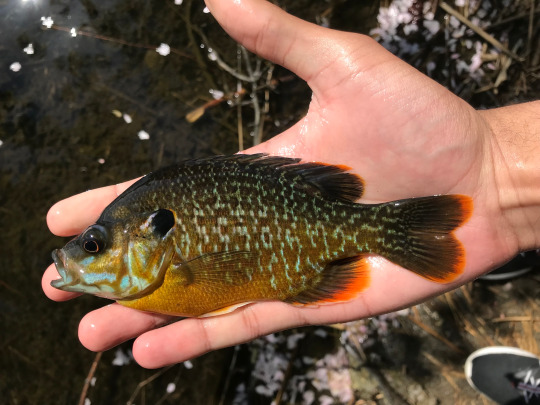
(Image: a greengill being held in someone's hand. It is more elongated than a bluegill and reatins the orange breast, blue chin, and black ear flap while being otherwise darker than most bluegills. End ID)
Bluegills are classified as least concern by the IUCN, meaning they are not in danger of extinction. Bluegills have been introduced to waters well outside of the native range by anglers and they have become an invasive species in multiple countries. They are banned from being imported in Germany and Japan because of how invasive they became. Bluegills are highly popular among anglers. They are small and easy enough to catch to be a good target for beginners and large bluegill are a good example of panfish, fish small enough to be cooked in a frying pan. Large males are particularly easy to catch due to their aggressive defense of their nest. Many places have very low populations of large males. Lakes and ponds are frequently stocked with captive-bred bluegill to attract anglers. Population management is important because bluegill can damage the local ecosystem if their numbers grow too large. They can also be introduced to ponds to try to help control aquatic insect populations. Bluegills have little fear of humans, especially in places where people feed them. I personally have been SCUBA diving in a quarry where people feed the fish and the bluegills swam right up to me. Bluegills that are very familiar with people are know to allow themselves to be pet. Bluegills can be kept in captivity, though they need large tanks and tend to be aggressive to other fish.

(Image: a larval bluegill. It is a long, white fish with small fins and a very large eye. A scale identified part of the tail as being 2000 micrometers long. End ID)
#wet beast wednesday#bluegill#sunfish#fish#fishposting#fishblr#freshwater fish#aquatic biology#biology#ecology#zoology#animal facts#informative#educational#image described
67 notes
·
View notes
Text
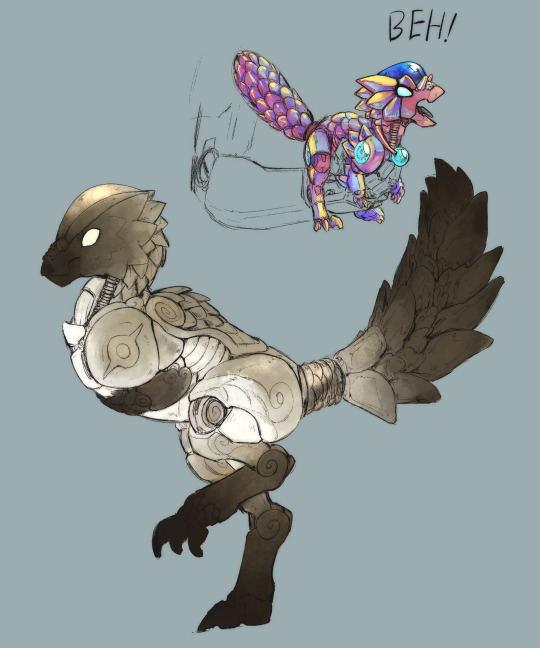
Some more crystal basher stuff.
Domestic bashers have cleaner and more symmetrical patterning than their wild relatives, who often appear a bit more “ai generated”. Their tails are also “bushier” and are often held up high when content. Smaller breeds tend to be much more vibrant in color than larger breeds.
When a crystal basher is new, their bodies are not quite as tough as fully mature bashers, which allows mechs to carve designs into their armor. It’s a harmless process and allows keepers to easily identify their basher if they were to get lost or stolen (have fun trying that in the first place💀)
297 notes
·
View notes
Note
Have you reviewed nimmos by any chance? They arent my favourite pet but i do think my dislike of them comes from how theyre posed rather than their actual design
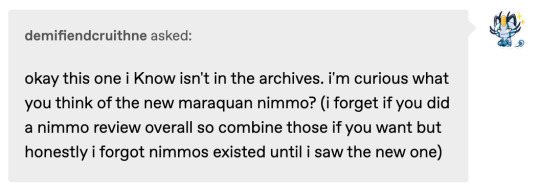
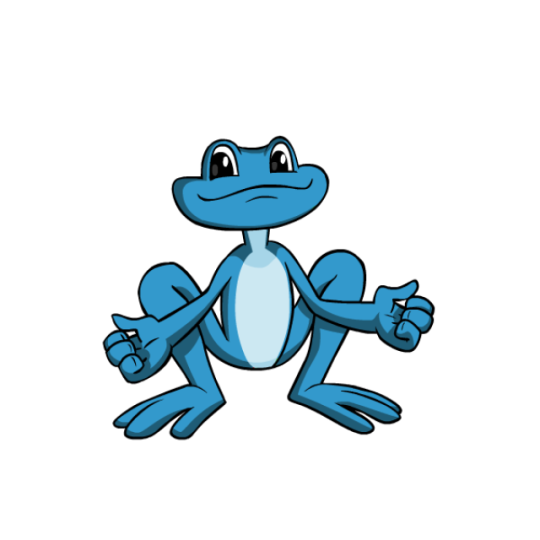
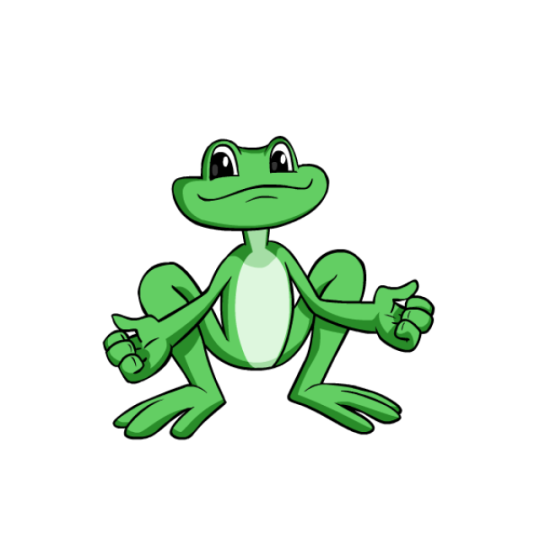
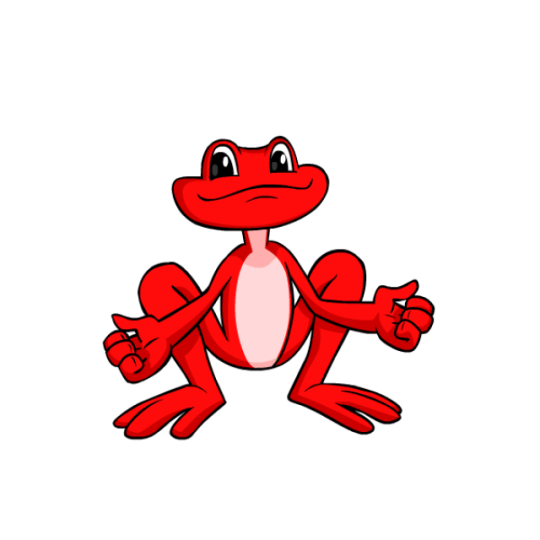
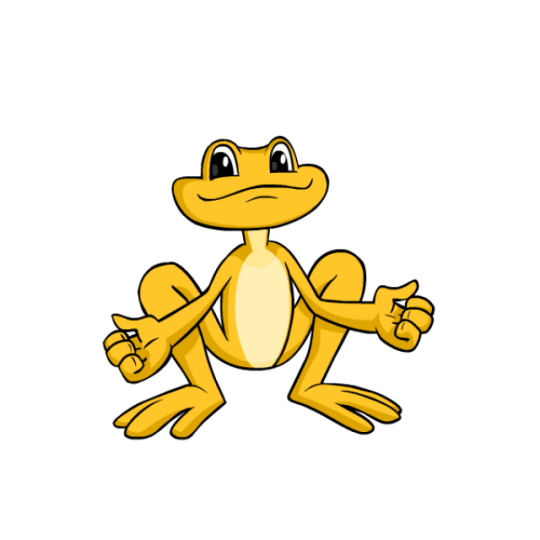
We actually have two different frog Neopets, but I will say they're pretty different from each other. While Quiggles are inherently silly guys and very short, Nimmos are tall and considerably less silly. In contrast, hey have a sort of meditative guru vibe to them, which is sort of evident in the pose with the hands and the stance.
In terms of the design, I like them overall. The wide mouth makes for a fun kind of :3 expression, and the body has a pretty distinct shape to it that makes it so they're not too much like a real frog. I could kind of take or leave the underbelly—I don't mind it, but they're thin enough that it doesn't feel like it's needed to break up the space, and it feels like it should go under the mouth as well or something.
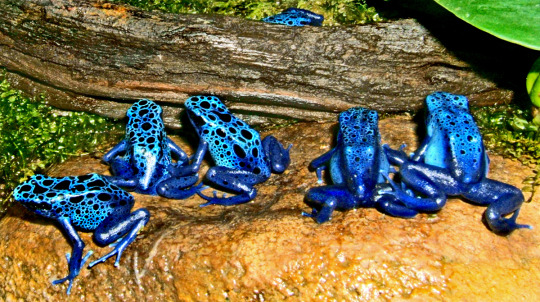
I also agree that the posing of these guys is a little weird, as they're stuck in like a weird sideways slav squat. I like the idea of them having long frog legs in contrast with the Quiggle, but the problem is that the knees of the legs go to the side instead of the front, when in reality they should be facing forward like at least 20% more and the top part should be more horizontal to the body. The butt being above the ground rather than on it also doesn't help anything. Oddly, there also aren't many options that let you break from this pose—even colors like Faerie maintain the same off putting leg structure.
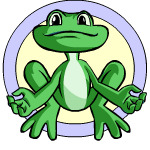
Nimmos have mostly stayed the same after customization and arguably improved, with minor fixes like adjusting the feet so they're actually at the right perspective relative to the body.
Favorite Colours:
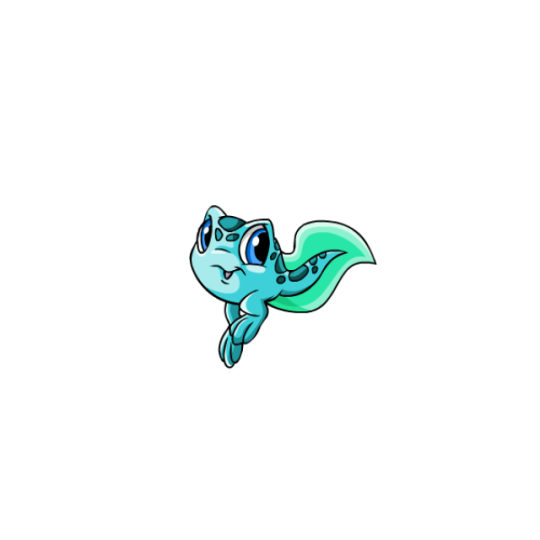
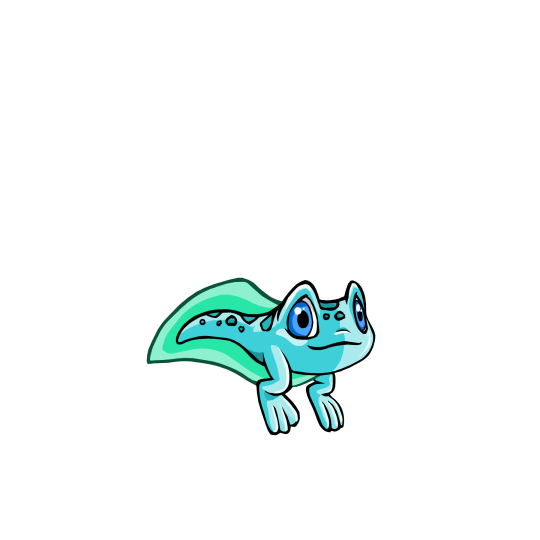
Baby: First off, having the baby Nimmo just be a tadpole is a great concept, and secondly, it's pretty cute as well. The face is just similar enough for it to still look like a Nimmo, and the dark spots on the body provide nice contrast with the more teal-ish colored tail. There's both a converted and UC/styled version, though this is a rare instance where the converted is way better—the pose is more lively, the pupils are larger so it looks less dead-eyed, and the shading has been improved.
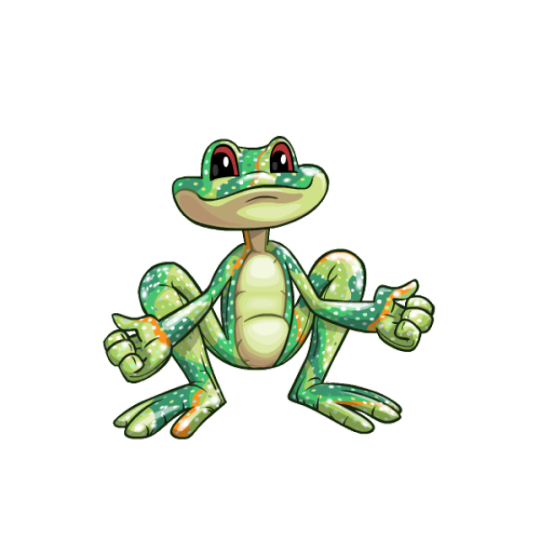
Toy: The toy Nimmo is actually based on the IRL Sand Critters frog plush, but even if you didn't recognize it off the bat, it's still a great design all around. The green and orange striping makes for a nice palette, the subtle spotting adds a nice texture, and the red eyes pop. Also, this kind of highlights what I was talking about earlier with the underbelly—it looks a lot more natural extended up onto the jaw.
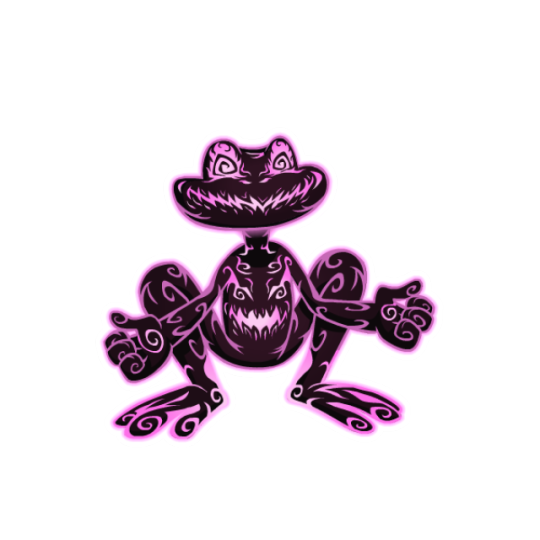
Wraith: The wraith Nimmo is not the best wraith pet or anything—the swirls are very arbitrarily placed over the body instead of contouring and playing with the body's actual shapes, and the bulk of the swirls are a bit too low-contrast. However, the big thing here is the lovingly detailed face... on the stomach, with a regular face to match. I have no idea why it's like this because no other Wraith pet does this, but damn if it doesn't look cool as hell, and more than makes up for the lack of flow in the rest of the body. I also really like the neat swirly pupils they used here.
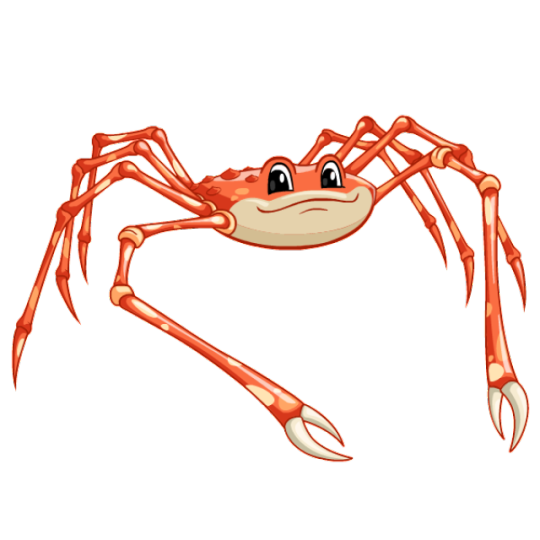
BONUS: The Maraquan Nimmo is both one of the worst and yet also one of the best Maraquan pets, and I absolutely hate and love it. Why is it a spider crab? Why does it just look like a normal crab with a Nimmo's face? Who cares. 10/10 get this thing out of my house
66 notes
·
View notes
Note
Your self insert looks cool do they have Lore
Ooo Pancake? Why yes, yes she does!! And a lot, actually. I'll TRY to keep this relatively short.
Pancake is my self insert/persona and I use her for almost everything. It's all Pancake in different universes. And there's two backstory categories that they all fall under: Demigod and Poor Teen.
But before all that, Pancake is a hybrid between an alien called a Terrorvant, and a human.

They are MASSIVE, some reading a size that's five times larger than a blue whale. And Pancake can only reach ten feet. They also have shape and color shifting abilities, though some traits will still poke out. And they have acid blood. That they can shoot from their mouths. At high temperatures and velocities. They are VERY protective of their loved ones. They'll make friends and let others make friends, but if someone threatens them or a loved one, HEAVEN HELP THEM. Pancake had inherited this.
Let's start with: DEMIGOD!!

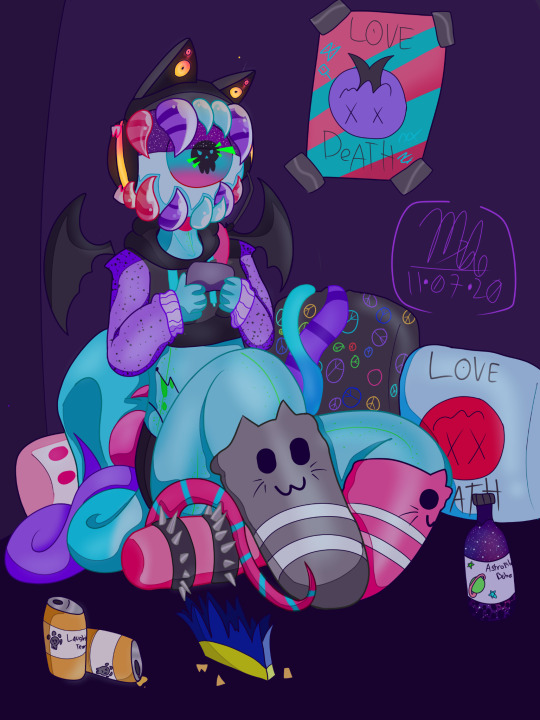
AUs this is a part of: Leave Death to the Professionals, I Scammed Death, and a couple others, I can't remember
Leave Death is the base universe where Pancake is from. All the lore bits and whatnot are from here. It's where Skittles is too. Pancake accidentally slipped and ended up killing herself, and through Death, found out she was a Demigod. And a necromancer. There's loss of morals, humanity, letting herself indulge in things she never could because there's no ultimate consequences. She is a nightmare, a menace, and be wary if you piss her off
I Scammed Death:
My self ship with Spamton. Pancake falls into the Cyber World and stays there indefinitely with her trash husband. How sweet :3
And now for the others: POOR TEENAGER. This one has no demigods or Skittles or anything else. Pancake and her friends like to ghost hunt, explore abandoned buildings, and try to summon ghosts. The summonings are typically uneventful, but they still have fun. Pancake, however, found an old book in a library about necromancy. Being silly, she took it to her friends and wanted to try the hardest spell. It wouldn't work, they felt, and there's no repercussions if they fail. Safe. Except she did the spell perfectly. And she's now a necromancer who can't die, can talk to the dead, and is having an existential crisis over it. A lot less dramatic than the Demigod category, but it fits into certain AUs better. Such as:
UNDEAD4UNDEAD: An AU where Pancake and Springtrap are together. (Ask me about this one cuz there's a LOT here). Pancake somehow can't leave the cursed Freddy Fazbear's franchise. It always comes back to haunt her. And she ends up getting a literal rotten boyfriend out of it

MSA/PANTHUR: This one is slightly different, on account she became a necromancer in her adult years. Her friends died in a caving accident, and she learned necromancy to bring them back. Unfortunately this never fully worked, as they moved on and she became a slasher. How she's a part of the Mystery Skulls is a mystery. But she's not knocking it. It also allows her to move on.
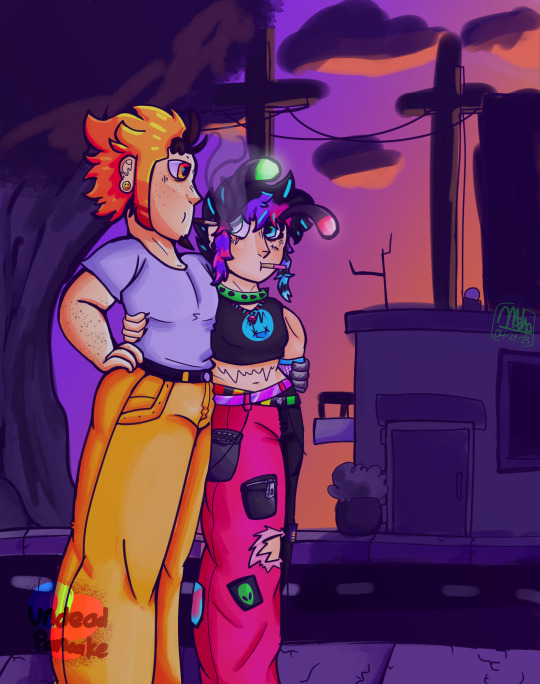
PORAL 2/OTCORE: Pancake was a scientist-turned-test subject. Because of her dad's genes, she had an advantage over the other subjects. And to compensate for this, the scientists cut off her spines, wings, antennae, and tails. And then put her on ice. And then GLaDOS killed everyone else. She takes place of Chell in this AU, and ends up with three boyfriends. She has no idea how. She lost her memory, has inexplicable phantom pains, and instincts she can't ever describe. Surgery scars are all over her body and she doesn't know why. It hurts. Existence hurts. And she doesn't know why.
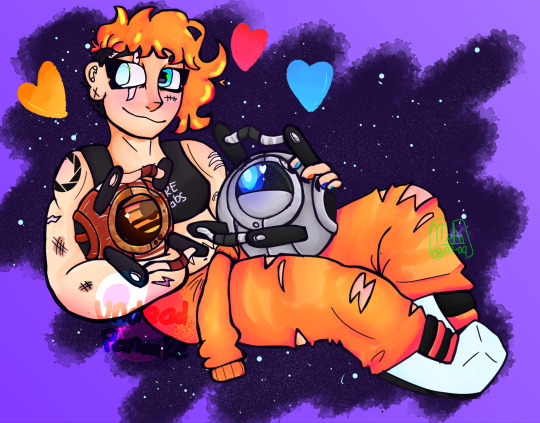
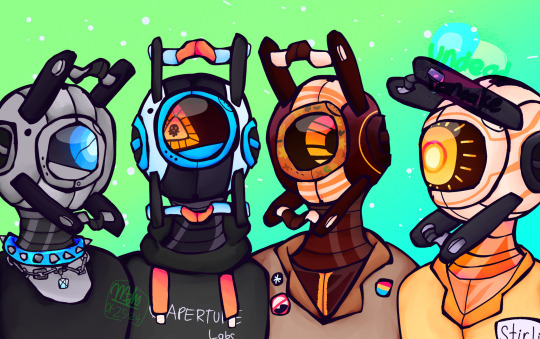
STARCAKE: everyone knows this one. Pancake falls into the Underground and eventually marries a cowboy. Not much here!!!
And now for others cuz they're in completely different universes
CULT OF THE LAMB: Pancake is the Lamb. She had to disguise herself as a cat for years after her home was destroyed. She learned Glassblowing, was found out and killed, and became the next God of Death. Her horns are glass, warm to the touch, and unbreakable. Her husband, is indeed, Narinder!
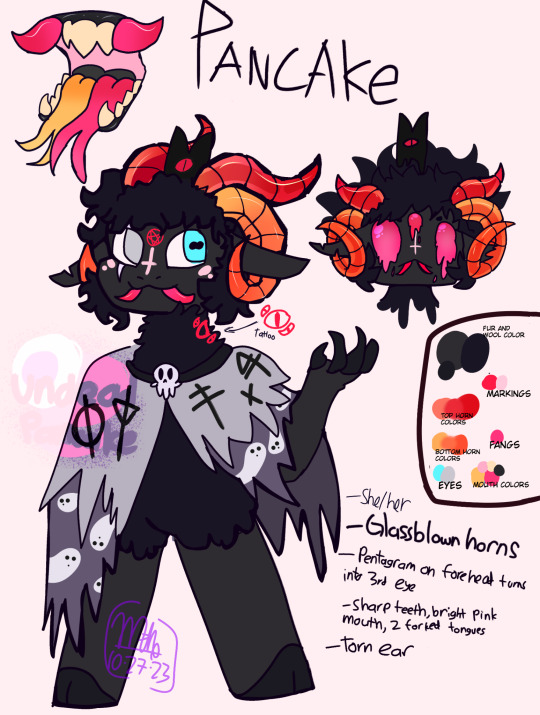
RAIN WORLD/FRUITSLICE: Pancake, AKA Fury of Neglected Ghosts, aka Ghost, is the senior in her group. She had to leave with her sister eventually, and met No Significant Harassment, as well as the others. She's MASSIVE for an iterator. Strong too. She has killed Leviathans with her bare hands. She acts cold and distant. She just doesn't wanna be hurt.
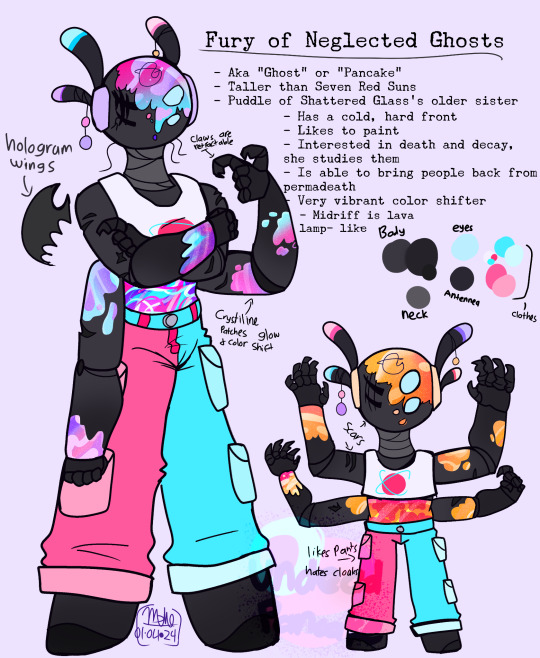
HOMESTUCK: Yeah. Fuchsia blood hiding as. Not that. And she's a nightmare too.
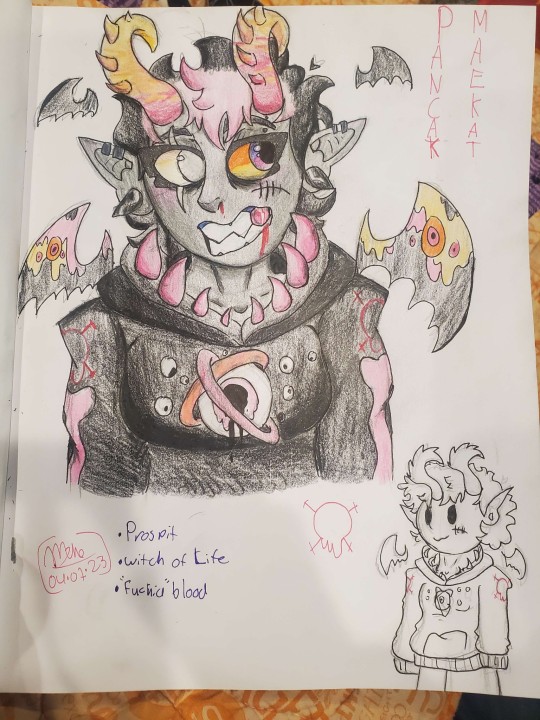
Anyway that's it. There's a LOT more but I haven't developed enough for them. And I hit my image limit. Hope this is fun!!
#hooo boy tagging#cake asks#self ship stuff#pancake aesthetic#leave death to the professionals#starcake#stuckhome#wheatcake#Undead4Undead#panthur#Fruitslice#🥞 cake art
25 notes
·
View notes
Text
Shobolon

Panels from Bone, © Jeff Smith
[Sponsored by @glarnboudin. Bone is a comic series that I remember reading and loving in undergraduate. And the "Stupid Stupid Rat Creatures" were my favorite characters. They pivot from menacing to comical and back on a dime, and have a very distinctive look. Their culture (or lack of it) has some very interesting world building implications, and they're one of the better riffs on the "evil minion species" in fantasy literature that doesn't go for wholesale deconstruction. However, they don't have much in the way of distinctive abilities in the comic. So I had to do some work to ensure that they were mechanically interesting.
A word about the name. In Bone, they are only known as "rat creatures", which says some alarming things if rats are sapient and seven feet tall. The name I went with was suggested by @abominationimperatrix. It's an Eastern European rat-ogre, but information on it in English is super sparse, to the point where different sources disagree whether it's Romanian or Romani.]
Shobolon CR 2 NE Monstrous Humanoid This shaggy, bulky humanoid has wide red eyes and a wide mouth full of sharp teeth. Its ears rise to a sharp point, and it walks on its knuckles.
Shobolons are voracious monsters that tend to live in large numbers. They are larger, stronger and slightly dimmer relatives of ratfolk, although the two species rarely interact on friendly terms. Their endonym is rarely spoken—most people just refer to shobolons as “rat-creatures”. Shobolons are omnivorous, but greatly prefer meat, and they don’t particularly care if their meat comes from sapient sources. They tend to fight from ambush, using their skill at climbing, swimming and squeezing into tight spaces to attack from unusual angles. They are fond of using the Intimidate skill to demoralize their foes, screeching hideously before moving to set up flanking positions or retreat from a losing battle.
Most shobolons engage in dramatic body modification. Their long scaly tails are docked shortly after birth (shobolon legends tell of these tails being used as handles by a wrestling demigod who humiliated them in the past), and their ears are cropped upon reaching adulthood in order to grant them a more threatening appearance. Shobolons do not have names of their own unless granted by a member of another species, or by their rulers as a reward for meritorious service. Despite their foolishness and lack of material culture, shobolons tend to be erudite, and like using long words in order to sound smarter (“hello, small mammal” is a common greeting/threat). Shobolons tend towards religion, and different hordes often venerate different gods or powerful fiends. Shobolons universally fear and hate dragons.
Shobolon Rulers Shobolons are very long lived, and display indeterminate growth. One that lives for hundreds of years and feeds well may grow to immense size and power. This growth is somewhat disproportionate, as their arms do not grow to scale with the rest of their bodies. A shobolon ruler often uses titles like King or Queen, regardless of how many shobolons they rule over. Such creatures are Large in size with 12 racial HD. A shobolon ruler has improved grab and swallow whole with its bite attack, gains frightful presence as a special attack and has undersized weapons as an SQ. A shobolon ruler is at least a CR 8 creature—many of them have levels in fighter or cleric beyond their racial HD.
Shobolon CR 2 XP 600 NE Medium monstrous humanoid (ratfolk) Init +5; Senses darkvision 60 ft., low-light vision, Perception +4 Defense AC 14, touch 11, flat-footed 13 (+1 Dex, +3 natural) hp 19 (3d10+3) Fort +2, Ref +4, Will +2 Defensive Abilities tight fit Offense Speed 30 ft. Melee 2 claws +4 (1d4+1), bite +4 (1d6+1) Special Attacks startle Statistics Str 13, Dex 12, Con 13, Int 10, Wis 9, Cha 10 Base Atk +3; CMB +4; CMD 15 Feats Improved Initiative,Skill Focus (Intimidate) Skills Climb +10, Escape Artist +7, Intimidate +8, Perception +4, Stealth +6, Swim +10; Racial Modifiers +4 Climb, +4 Escape Artist, +4 Swim Languages Common Ecology Environment temperate forests and hills Organization solitary, pair, troop (3-8), army (9-24 plus 1 2nd-4th level fighter per 20 individuals) or horde (25-200 plus 1 2nd-4th level fighter per 20 individuals and 1 ruler) Treasure standard Special Abilities Startle (Ex) A shobolon can make an Intimidate check to demoralize an opponent as a move action. An opponent intimidated by a shobolon cannot make attacks of opportunity as long as it suffers from a fear effect. Tight Fit (Ex) A shobolon suffers only half the usual penalty to Armor Class and attack rolls when squeezing. Two shobolons can fit in the same space and fight without penalty.
98 notes
·
View notes
Note
Emilute is such an interesting opportunity for both characters. Why? Well…
It all depends on where the characters are taken in thd pining wings au.
Me personally, I like the idea of these two bettering themselves before they EVER even consider becoming a couple. I like the idea of Lute drowning in her shame and guilt when she sees what she caused. I like the idea of Emily growing and learning that it was not HER fault. I like the idea that she teaches Lute what Sera taught her about love. I like the idea of Lute accepting an olive branch of friendship from her and it eventually grows into something more. I like the idea that Emily is just like Sera when it comes to someone flirting with her and remains willfully oblivious. I like the idea that Lute is pining for her but gives up and starts helping Carmilla more with weapons testing. I like the idea that Emily notices Lute’s absence more and more because she misses all the little things they had together, like how protective she was of her when they went for walks, how she would laugh at her terrible jokes, how warm her disproportionate left hand was compared to her right one…oh.
I love the potential that can be bounced back and forth between these two that makes them both grow as characters.
Read this and this first.
Emily had tried to convince herself the Sinner she kept spotting around Hell -- the one who looked so much like Lute, reminded Emily of her, but couldn't possibly be her --wasn't Lute. Every time she ran across them on the street, she'd call Lute's name, but the Sinner would run.
She doesn't know why she keeps calling them by that name. If only she knew their true name, she could help them! They looked worse and worse, every time they ran across each other. But they would always high tail it out of there before Emily could even speak to them!
Until the day the Sinner couldn't run anymore. Emily is walking with Odette and Clara, who are usually her chaperones when she needs to go anywhere down here, because it's not safe for a pure-blooded angel alone. Emily spots a light black and silver wing poking out from beside a dumpster. The closer she gets, the more feathers she sees, and claws, and jet-black hair. The kicker, though, is the person is absolutely drenched in golden blood. They are caked with it. Saturated. Emily isn't even sure if the person is still alive.
It's them, Emily thinks. That Sinner...the one who looks so much like Lute!
"Hey!" Emily says, running toward them. Emily dares not fly. Not out here in the open. Not that her wings don't stand out, as it is, but in the air, she is a sitting duck for one of the overlord Vox's drones, if she's not careful.
"Emily!" Clara shouts. "Where are you going?"
Emily ignores her. She falls at the feet of the figure she's been chasing for weeks now. They are lying face-down on the ground, arms twisted in a weird configuration. Wait, no...not twisted. Their arms are just different sizes. One looks human, the other larger. More like bird talons.
Emily turns the figure's head so it's lying on its side, out of the puddle the body fell in. It's a miracle this person hadn't drowned in that few inches of water. With their face turned toward her, Emily can finally see all the little details of their features.
It is a woman. One eye missing -- the hole in her face gouged out and puffy; obviously a relatively fresh wound. Hair caked with dried, golden blood, and a pair of twin black horns sticking out of it, giving Emily something to hold onto as she moves the person's head out of the water. Emily then grabs her under the arms, and pulls her completely out of the puddle. A black, serrated tail is revealed, and drags behind her as Emily pulls her closer to the sidewalk and away from all the trash and debris.
Now Emily can get a good look at her face. By the light of a streetlamp, the Seraphim can now see her greatest fears made manifest. The woman -- the misshapen, mangled, near-dead woman, who is slowly coming to and opening her good eye -- is Lute in the flesh!
There is no mistaking it. The hair, the horns, the tail, every other feature is completely foreign to what she's used to. But when she looks into that eye, and sees the smallest, most miniscule bit of recognition shining back at her, Emily knows.
Emily cups both hands over her mouth, tears forming in the corners of her eyes, as she gasps out the name she wishes she didn't have to say. She desperately wishes it. Lute shouldn't be here. She shouldn't...
"Lute."
"Emily?" Lute asks. The Exorcist tries to push herself up on her forearms, to get a better look at her savior, but then she screeches in pain, the talon-like arm giving way under her weight almost immediately. Lute tries again, and falls again, screaming into the sidewalk.
"Lute, stop!" Emily shouts, kneeling at the Exorcist's side. Now that she can better see the arm, she can see all the blood coming off of it. There are black feathers sticking out of the larger of Lute's arms, everywhere, revealing dark gray skin and pinpricks of golden blood underneath.
The feathers are seriously thinned out, like a sick bird that's been molting from malnutrition. But the blood coming out of the arm is fresh. And there are black feathers everywhere, littering the ground all around them. Emily looks at them, noting the distinction between the solid onyx feathers of her arm, and the lighter black and gray ones on her wings.
The feathers on the ground must have come from her arm. They are relatively healthy-looking, as well. The little pinpricks of gold all over the skin of her arm...the ones that are bleeding from wounds that are way too fresh to have been from wings falling out naturally...
Lute had been pulling them out. One by one, agonizing feather by agonizing feather, and the blood loss must have been excruciating.
Lute tries to push herself up a third time, and falls for a third time, pounding her human-like arm into the ground in frustration. She's crying, back to lying face-first on the ground like a helpless baby bird that's fallen out of the nest.
Emily doesn't hesitate. She stoops down, whispering to Lute, "Be still. This might hurt," and picks her up bridal style, holding all the soldier's weight in her tiny, Seraphim arms. She's stronger than she looks, though.
Lute screams, and groans in pain, but once she's settled, she practically sinks into Emily's arms, exhausted. She's shaking all over. She's in shock.
"Emily..." Lute tries to speak again.
"Hush. I'm going to get you some help."
Emily looks all around for where she left Clara and Odette across the street. They're standing under a streetlamp on the opposite side of the road, staring at them both, gobsmacked. As Emily brings her precious cargo closer to them, Odette steps back in recognition, fear flashing in her eyes behind the lenses of her glasses.
"Is that...?" she starts, almost too afraid to ask. "Is that an Exorcist?! What's wrong with her?!"
"Yes," Emily says. She doesn't know how to justify any of this. What she's doing. Why she's currently holding the enemy in her arms like a piece of almost-dead roadkill. "She's my...she was my friend. She needs help! Please! Maybe Sera or your mother..."
"I don't know about this, Em," Clara says. "She's an Exorcist! She's killed thousands of our people!"
"You guys forgave me!" Emily says, point-blank, like it should be obvious. "I don't know what she's doing here, or what happened to her, but...she needs my help! I can't just leave her here to die!"
The Carmine sisters look at Emily, and then at each other, completely at a loss for what to do. Clara is quicker to forgive than her older sibling. Emily looks at her, pleading with her eyes.
Clara shoots Odette another glance, eyes softening a little bit, and Odette looks like she wants to protest. But Clara steps up to override her.
"Come on," Clara replies, forgetting about the errand they were supposed to run. It will have to wait. "Let's get her to Mom. Maybe she can figure...something the fuck out!"
Emily smiles at Clara. She's almost on the verge of tears. "Thank you!"
"Don't thank me just yet," Clara mumbles. "Wait until Mom hears about this!"
It's enough for now, Emily thinks. She knows she can explain this to Carmilla...somehow.
Emily looks back down at Lute in her arms, who has completely passed out again, oblivious to the three young women who had just been debating her entire future, her survival, her very existence, right in front of her without her knowing.
Emily follows the sisters home. She doesn't know how she'll explain this to Sera, let alone Carmilla...but she'll come up with something! She has to!
#hazbin hotel#carmilla carmine#sera hazbin hotel#emily hazbin hotel#clara hazbin hotel#odette hazbin hotel#lute hazbin hotel#ask#fan theories#vox hazbin hotel#emilute#pining wings au
40 notes
·
View notes
Text
Some dragon lore that might be considered more headcanon that I made up for my fic that I’m just gonna share with the rest of the HTTYD fandom, because I’m fully aware many may not read my fic as it’s a crossover with a teeny tiny show relatively no one’s heard of
- Gronckle’s, Catastrophic Quakens, and Eruptodon’s are related species that evolved in different ways (other related species chains will involve Night Fury-Light Fury-Woolly Howl-Sand Wraith, Hideous Zippleback- Venus Snapptrapper, Boneknapper-Armorwing-Sword Stealer and maybe Timberjack-Typhoomerang)
- Monstrous Nightmare’s are surprisingly strong swimmers and fond of the water, considering they’re a staple Stoker Class dragon with their ability to set themselves on fire
- Deadly Nadder’s have horrible depth perception and used to be a smaller and typically prey-dragon for the cannibal species, which is why they evolved both their spiny tails and such a heightened sense of smell. Lack of depth perception that helps you pinpoint where something is doesn’t mean much when you can either sniff it out or shoot spines in almost every direction as a defense mechanism
- Hideous Zippleback’s are the most well-adapted to life on the ground, especially in wooded areas, amongst the other more common dragon species, and are also the fastest runners. They’re almost better runners than they are fliers. They’re also incredibly good ambush predators, with perfect camouflage in forest environments and impressive stealth, and in areas where there are little other dragons, especially a dragon larger than them, are usually the top of their food chains, which is why they’re one of the bigger of the common breeds (Ala Nightmare’s, Gronckles, and Nadders)
- Speed Stingers fight each other in a similar manner to jousting, but on a much faster and dangerous level, with a bit of the game Chicken thrown in as well
- Deadly Nadder’s are actually a Dual Class dragon, fitting perfectly enough in both the Sharp and Tracker Class that they were categorized into both
- Bewilderbeast’s and the Red Death’s species are both sexually dimorphic, but more in regard to size. Male Bewilderbeast’s are the ones that get so large, hence the name ‘King of Dragons’. The same applies in reverse to the Red Death’s species, with the females the ones that grow to the giant sizes, earning them a similar name ‘Queen of Dragons’. This is also why there are so few of these giant dragons around; there’s a very short window in which they can mate with the opposite sex, before it becomes too dangerous or risky for the smaller partner. Few naturally born males or females of the respective species ever hatch, so they evolved to have long lifespans as a whole, and the smaller sex of each species also evolved the same trick the dinosaurs in Jurassic Park and the frogs they were made with developed; instant transgenderism
- Singetails evolved their complex fire-breathing system as a defense mechanism against the Skrills that were hunting them, and Skrills evolved their long-ranged electrical attacks in retaliation
- The type of lava blast a Gronckle shoots can vary depending on what kind of rocks they ate to prepare for the blast, or what kind of rock diet they usually eat
- Light Furies are glittery because they can often be found near warmer but still polar regions, where the sparkling helps them blend in with the snow. Light Furies also get chunky with blubber the colder the area they live in gets; they adapted to adjust their body weight depending on how much heat they needed to retain due to their surroundings
- Woolly Howls and Snow Wraiths often fight with one another as they live in the same environments and clash over territory
- Monstrous Nightmare’s aren’t necessarily a species that mates for life, but they are one of the species that will keep going back to a certain partner if they liked them, and sometimes refuse other suitors in favor of a repeated partner they’re fond of. They also raise their hatchlings well into young adulthood, unlike some species who wait until the babies can fend for themselves. Some Monstrous Nightmare chicks will even seek out their parents and siblings well into adulthood to check up on them and catch up, or even stay with them
- Night Furies and their related species are like whale pods, who teach lessons and skills through generations and live in family units. Many of a Night Fury’s hidden skills have to be taught by another dragon of the same species, unlike other species who instinctually learn them as they grow. They also age at relatively the same pace as humans, mentally and physically
- Some Gronckles can actually develop allergies to certain rocks and minerals, and have preferences for what rocks they’ll eat in the same way other dragons will prefer a certain kind of fish or game over something else. Gemstones and jewels are kind of like candy to Gronckles
- All the ‘cannibal’ species (Deathsong, Skrill, Deathgripper, etc.) don’t rely on just dragons for their diet, as dragons are some of the hardest prey to catch. Even Cavern Crashers don’t rely on just dragon eggs for their food; they’ll eat any small animal they can get their teeth on, and if they’re lucky, nests of other egg laying animals
- Skrills will also hunt Flightmare’s if presented with the opportunity, as well as some of the smaller ‘Terror’ dragons species (Night Terrors and Terrible Terrors), but they’re also really fond of sheep. They don’t eat fish like most other dragon species unless they find it dead somewhere else, or steal it from another dragon, and that’s if the Skrill even has a taste for fish. This is due to the fact that water is their biggest weakness, and fishing means getting wet and making themselves very vulnerable, which means most don’t even develop a taste or liking for seafood
#it is my goal to not necessarily FIX the Light Fury design#rather to ADD to it and find a way to make it make sense#i hope the headcanon/lore I added here pleases some people regarding that species#and any of these other one’s really#some of these are a little more headcanon-y than others#but a lot of these was me coming up with lore I felt actually fit the dragon in canon#and also with my fic#httyd#httyd dragon lore#httyd dragon headcanons#tagging both#adding the tag for my fic at the end purely because most of this ends up in it and I came up with it for the fic itself#httyd/the deep crossover
23 notes
·
View notes
Text

Allenypterus montanus was an unusual early coelacanth that lived during the late Carboniferous, around 324 million years ago, in a tropical bay covering what is now central Montana, USA.
Up to about 15cm long (~6"), its tapering tadpole-like body plan somewhat resembled that of modern knifefishes and featherbacks, with the top part of its tail fin highly elongated into a ribbon-like shape and the rest of its tail fins being vestigial. The distinctive humped shape of its back was also much more pronounced in larger, more mature individuals.
It was probably a fairly slow swimmer, and preserved gut contents suggest it mainly ate small soft-bodied prey.
Its closest known relative seems to have been the eel-like Holopterygius – but since around 60 million years and different continents separated them both, this suggests the existence of a whole ghost lineage of other tapering coelacanths yet to be discovered.
———
NixIllustration.com | Tumblr | Patreon
References:
Friedman, Matt, and Michael I. Coates. "A newly recognized fossil coelacanth highlights the early morphological diversification of the clade." Proceedings of the Royal Society B: Biological Sciences 273.1583 (2006): 245-250. https://doi.org/10.1098%2Frspb.2005.3316
Lund, Richard, and Wendy Lund. "New genera and species of coelacanths from the Bear Gulch Limestone (Lower Carboniferous) of Montana (USA)." Geobios 17.2 (1984): 237-244. https://www.academia.edu/download/66985268/s0016-6995_2884_2980145-x20210504-8876-dzniic.pdf
Lund, Wendy L., Richard Lund, and G. Klein. "Coelacanth feeding mechanisms and ecology of the Bear Gulch coelacanths." Compte Rendus du Neuvième Congrès International sur la Stratigraphie et la Géologie du Carbonifère 5 (1985): 492-500. https://www.researchgate.net/publication/285577607_Coelacanth_Feeding_Mechanisms_and_Ecolqgy_of_the_Bear_Gulch_Coelacanths
Toriño, Pablo, Matías Soto, and Daniel Perea. "A comprehensive phylogenetic analysis of coelacanth fishes (Sarcopterygii, Actinistia) with comments on the composition of the Mawsoniidae and Latimeriidae: Evaluating old and new methodological challenges and constraints." Historical Biology 33.12 (2021): 3423-3443. https://doi.org/10.1080/08912963.2020.1867982
#science illustration#paleontology#paleoart#palaeoblr#allenypterus#actinistia#coelacanthiformes#coelacanth#sarcopterygii#lobe-finned fish#fish#art
327 notes
·
View notes
Text
I've had an idea knocking around in my head for a while to draw every single dragon from the wider httyd universe, including everything from the books, to the main DreamWorks franchise, The Nine Realms and even Rescue Riders. And as I go through redesign them (to varying degrees) to fit my style, and let out my biology and ecology nerd a bit with some headcanons for them.
I've got no idea how many Dragons I'll get done, but I figured going A-Z is the best way to do it, so without further adieu;
The Armorwing
(DreamWorks Franchise)
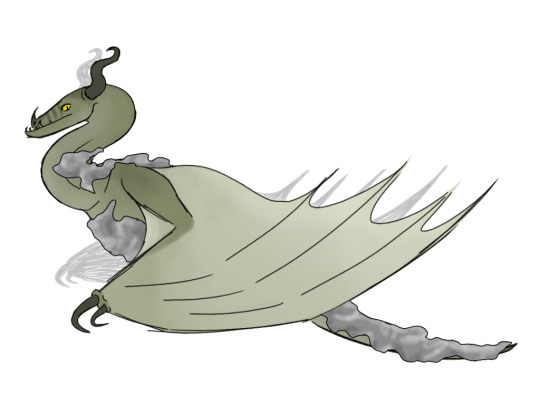
Headcanons below the cut
The Armorwing is the closest living relative to the Boneknapper, though it is also distantly related to the Sword Stealer and some Stoker Class Dragons.
Their neck is long and flexible, allowing them to see - and breathe fire upon - every part of their body.
Their fire is among the hottest of all dragon fire, but is very short range, reaching barely even a full body length. It cannot be shot in single blasts, like most dragon fire, and can only be sustained for a few short seconds.
Naturally the Armorwing will inhabit caves, cliffs, and rocky, exposed terrain, places where they are most likely to find minerals. They dig said minerals from the ground using their talons and the claws on their wings.
However, Armorwings have adapted amazingly well to the explosion in human civilisations, very quickly learning that a Viking village will have much more metal that conveniently isn't buried under mounds of rock. If you find an abandoned village, you'll almost certainly find an Armorwing that's made their home there.
It is not uncommon to find an Armorwing living with a village that is friendly towards Dragons, since the dragon needs metal to keep itself protected and the humans often find themselves with scrap metal that they can't reuse for anything.
Their eyes are incredibly sensitive to light, which is useful for spotting bright glints of exposed metal but makes being active during the day difficult. Because of this, they are mostly crepuscular (most active at dawn and dusk), when the daylight isn't as harsh on their eyes.
Armorwings are solitary. Each dragon has their own territory, and they do not encroach on others. Larger, older Dragons with more elaborate metal coverings often get first choice for new territories. They also don't coexist particularly well with other Dragons, with Smothering Smokebreaths being their biggest issue, but Skrills and many metal-eating Boulder Class Dragons also proving a problem.
Armorwings do not mate for life, they simply choose whichever partner has the armour they most like every season. Armorwings will often add more colourful, eye-catching details to their armour during breeding season specifically to attract partners. Females lay about 3 eggs a year, and care for the hatchlings for a month or two until their fire is hot enough to melt metal and they're about Gronkle sized, after which the Hatchlings are chased out of the mother's territory to fend for themselves.
Their armour tends to be concentrated around their most vulnerable points. Their chest and belly have the thickest armour, but it also encompasses their back and tail. Older individuals have more extensive, elaborate armour. However, fused metal does restrict movement quite significantly, so the armour on their neck, when present at all, tends to be rather thin and segmented to still allow them the range of motion needed to keep applying more.
Armorwings have thick, bulky legs and wide feet to support the weight of all the metal covering them. While they can stand up on just their legs, they primarily walk using their wings to help alleviate the weight. Their wings themselves are much more adapted to walking than they are flying, and while (most) Armorwings can still fly, it takes significant effort, so is mostly kept for only extreme circumstances.
Bonus Armour-Less sketch.
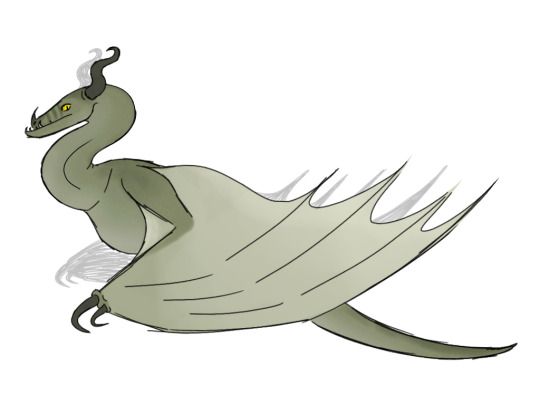
#httyd#httyd fanart#httyd headcanon#rtte#how to train your dragon#how to train your dragon fanart#race to the edge#armorwing#Amity Doodles#Amity's Dragons A-Z
49 notes
·
View notes
Text
Why We Need to Care About Insects
Originally posted on my website at https://rebeccalexa.com/why-we-need-to-care-about-insects/
Some months back a study was released that demonstrates just how damaging climate change is to insects, particularly those in tropical areas. Warming temperatures cause insects to die from overheating and dehydration, kills off their food sources, and lowers their fertility rates to dangerous levels. Moreover, changes in climate affect insect phenology, the timing of when they hatch, migrate, breed, and so forth.
And because insects are so small, they’re often disproportionately affected by many of these problems. As ectotherms, they rely on the air around them to regulate their body temperatures; their small mass means they lose heat faster than larger animals, and can be overloaded with heat much more quickly. Tropical insects are especially at risk from major fluctuations in temperature because they are adapted to a relatively narrow temperature range.
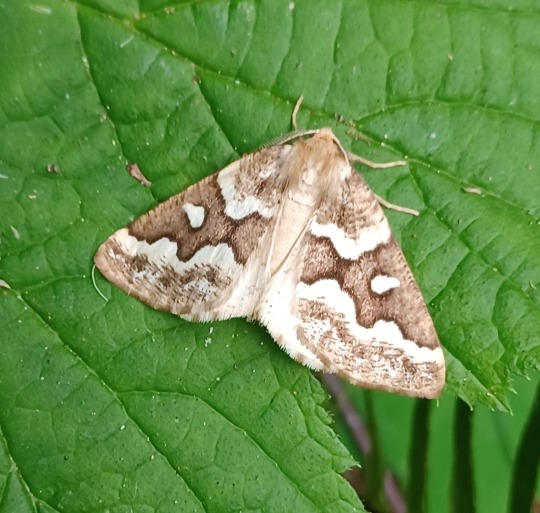
Gray spruce looper moth (Caripeta divisata)
But the problem goes far beyond the tropics, and we are in the middle of an insect apocalypse. This problem often flies under the radar of those who are not already aware of invertebrate conservation. While a few insects, such as monarch butterflies (Danaus plexippus) and domestic honey bees (Apis mellifera), find themselves in the press on a regular basis, most species don’t have large fan clubs. Some of my favorite insects include the white-tipped ctenucha moth (Ctenucha rubroscapus), the velvet snail-eating beetle (Scaphinotus velutinus), and the black-tailed bumblebee (Bombus melanopygus), none of which are insects you’re likely to find making the headlines.
To be fair, there are a lot of insect species out there, so it would be hard to feature every single one individually. But we already face the problem that many people simply just don’t see why we need to worry about fewer bugs around. Last year I wrote an article about how search engines tend to produce exterminator sites at the top of results for various insects, and while some of that is no doubt due to advertising-oriented algorithms, they do reflect a widespread demand for extermination services that isn’t matched by more positive attention to these little animals.
Much has been said among entomologists, ecologists, and other professionals about why we need to be concerned about the drastic drop in the numbers of many insect species, and I’ve written about it as well. I could reiterate what would happen if we lost our pollinators (and also how to save them!) or the crucial role insect detritivores play in reducing diseases and keeping the food web cycling along. And I am still a champion for mosquitoes and other unpopular insects.
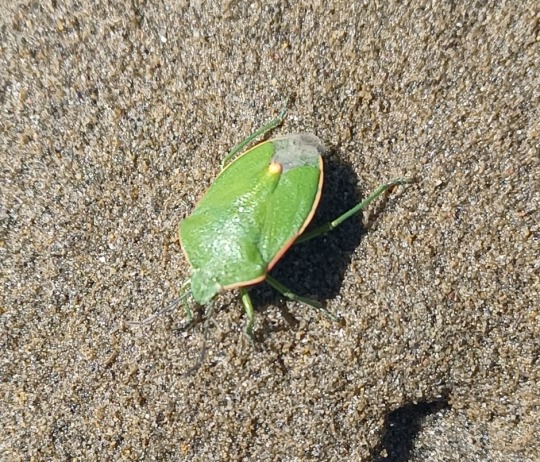
Green stink bug (Chinavia hilaris)
But these things always bear repeating. It may be that nine out of every ten organisms on this planet is an insect. Insects play an incredible number of ecological roles, from ecosystem engineers to pollinators to food sources and much more. Without them, ecosystems around the planet would collapse entirely.
I could certainly take the self-interested route and emphasize that fully one-third of our food relies on insects and other pollinators. I might also point out that insect detritivores help nourish the soil needed for everything from food crops to timber. While terrestrial insects and other arthropods only make up about a fifth of the amount of global biomass as their marine counterparts, they still represent a natural sink that holds about 200 million tons of carbon at any given time.
But our anthropocentric worldview rarely considers the intrinsic value of insects simply for existing. We’re constantly weighing and measuring their worth based on our biases and values. We divide them into “good” or “bad” insects: good insects are those that do things we like, like pollination or looking pretty, while bad insects are the ones that chew on our homes and plants or which bite or sting us when threatened or seeking food. For a lot of people, any insect beyond maybe a butterfly is a reason to say “Ewww, gross!” I’ve even seen this widespread among self-professed nature lovers, whether they have a true entemophobia or not, though there may be an evolutionary reason for this seemingly disproportionate reaction.
So consider this yet another attempt to change opinions about insects. I can’t cure entemophobia, but I can at least get people thinking more critically about personal and societal attitudes toward insects. I hope to get people to realize that widespread use of pesticides and other garden/agricultural chemicals–which has increased fifty-fold in twenty-five years–is driving the loss of so many insects. I’ve mentioned before that habitat loss is the single biggest cause of species endangerment and extinction, and that goes for insects, too. And, of course, the study mentioned at the start of this article is just one highlighting the increasing impact climate change has on insects worldwide.
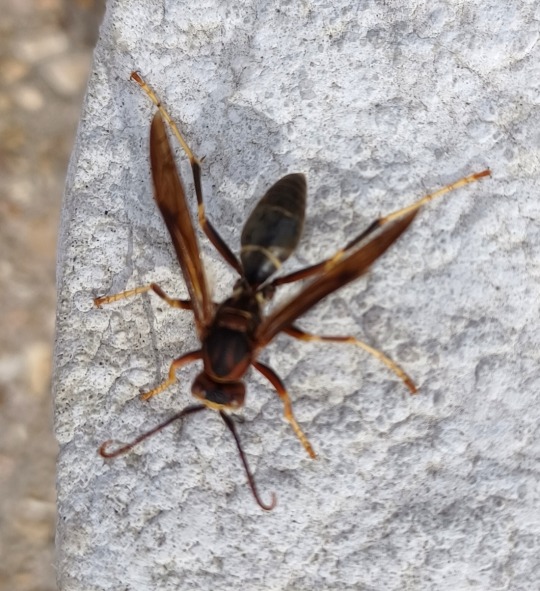
Metric Paper Wasp (Polistes metricus)
Let me wrap this up on a bright note: word is getting out. There is a lot more awareness than there was twenty years ago, and there’s more nuance than we had in the early “save the (domesticated European honey) bees” campaigns. More people are ditching pesticides and other garden chemicals unless absolutely needed, and regenerative agricultural practices that use fewer chemicals overall are gaining ground. And while numerous organizations are increasing awareness of insect conservation, the Xerces Society for Invertebrate Conservation–the oldest organization dedicated solely to invertebrates–is still going strong.
And you can help spread the word, too. Share this article with others, and some of the resources and organizations linked throughout. Consider your own relationship to the native insects in the world around you, and whether you might make their lives a little easier. And remember that sometimes it is the smallest of things that have the greatest importance in such a massive system as an entire living planet.
Did you enjoy this post? Consider taking one of my online foraging and natural history classes or hiring me for a guided nature tour, checking out my other articles, or picking up a paperback or ebook I’ve written! You can even buy me a coffee here!
#insects#CW insects#moth#beetle#wasp#bugs#invertebrates#insect apocalypse#climate change#environment#conservation#endangered species#extinction#sixth great extinction#wildlife#nature#animals#ecology#science#scicomm
154 notes
·
View notes
Note
Ao’nung x Sully hybrid fem reader
(reader is omatikaya and metkayina mixed)
Takes place in the Metkayina Village
When men from both clans try and court the reader because of her body (because she had a big chest and butt) so she has to deal with men constantly trying to win her over even though they all know she has a mate already but they don’t care so when one of them gets frustrated and starts to say mean things about her and saying “your mate only wants u for your body and nothing else” to her to make she feel insecure about her body (because reader is very confident about her body and is not afraid to show it off to people letting people know how confident she is about herself) so she starts loss her confidence over what the guy said about her so unfortunately she starts to question Ao’nung about if he loves her for the only her big chest and butt. And Ao’nung is trying to convince reader that’s not the reason why he chose her out of all people to be his mate.
Do you really love me?
Ao’nung x Hybrid!Sully
warnings : Body shaming..?, bit of violence, fluff
word count : 2.3k
a/n : omg this is my first request it’s so exciting. There are some small things I had to switch around since the only people from omatikaya in Awa’atlu are the sullys. Anyways I really hope you enjoy this :)
_
Before Lo’ak or Kiri was born, along the outskirts of the village layed a small infant. An infant with unique features that no other Na’vi in the clan has seen. Your skin is dark blue and eyes yellow like the rest but your limbs and tail are thicker compared to any other babies. It seemed as if you were abandoned. When a warrior discovered your tiny body, they quickly alerted the Olo’eytan, Jake. When Jake saw your small frail figure curled into a leaf, his heart tightened. Bringing you to Neytiri, his eyes showed much love. Neytiri has a mutual feeling seeing you in his arms. Your small arms reached out to tug onto Jake's hair as you let out a small giggle when Jake tried to get out of your tight grasp. They both knew that they wouldn’t let you go to anyone else as you stole their hearts. Only being a few months younger than Neteyam, you got along well.
As years pass, the more you mature. Both brothers had a very protective nature over you especially since you were a bit different. Despite being older than Lo’ak it seemed as though he was more protective than Neteyam. Another reason for their protectiveness was because of the men in the clan. Ever since you completed becoming one with the clan, you were allowed to pick a mate. Because of your different features, it caught the eyes of many. Your body was different from other girls in the clan, yes, but there were also some other differences. Most female Na’vi had relatively smaller chests and slimmer behinds. Though for you those proportions were slightly larger. That made the men in the clan more persistent in making you their mates. Their persistence had you constantly annoyed. Your brothers and even your father had to step in at times because of how bad it got.
The worst part about it was the comments that were thrown at you. Certain comments made you very conscious about your body and it felt horrible. Not being full forest Na’vi already made you insecure about yourself but adding certain body features made it worse. But ever since the Skypeople returned, there have been many changes. Being caught by dream walkers was never a part of your future plans. But even then they made comments about your appearances and disgusting ones as well. These events led to leaving your home. You were definitely upset about this but a small part of you was washed with relief. Leaving your home was one of the hardest things any of you had to do, especially your mother. Jake never mentioned where you would be heading. But your eyes widen as you arrive at a line of islands filled with Na’vi who resembled you but with lighter skin tone and beautiful blue eyes.
As your parents asked for Uturu, a certain boy caught your eye as he studied your brother's features. His eyes then moved to you, a slight look of shock as he noticed your appearance. His curious eyes looking over your body made you feel self-conscious. He noticed your discomfort and immediately stopped and moved his eyes back to your brothers.
_
Living in Awa’atlu for the past couple weeks has been quite amazing for you. Despite missing the forest, it felt as if you belonged with the reefs. The boy who eyed you on the first day whose name is Ao’nung has been extremely nice to you throughout your stay here. Although your brothers could say different. But Ao’nung treated you fairly and never made comments about your appearances. It felt refreshing to hang out with a boy who isn’t constantly trying to court you. Even though Ao’nung treated you normally it seemed as though your looks caught the eyes of more men within the clan, just like in the forest. Things were repeating once more with the constant courting and persistence with becoming mates. The only difference now was Ao’nung was there to help fend off the guys even though you were perfectly capable of defending yourself.
There was one time where a metkayina warrior tried courting you and he ended up grabbing your arm. That was a big mistake. You quickly got out of his grasp and shoved him to the ground as you bared your teeth. Ao’nung witnessed it all and that scene was like slow mo for him. His heart sped up as you showed your strength as a strong warrior. He knew he liked you since he first laid his eyes on you but this just made him fall for you even harder. Ao’nung genuinely likes you and not just for your appearances. The way you speak, the way your eyes glow at the sight of the colourful reef. Everything about you was remarkable to him, but he wanted to move cautiously knowing how you reacted to men trying to make a move towards you. The only thing he didn’t know was you were slowly catching feelings for him as well. The one boy who treated you with respect and he was sweet with you. Lo’ak could see what was sparking between you two but before he could push Ao’nung back, both Neteyam and Kiri held him back seeing how you look at each other.
The relationship between you two blossomed as days passed. Though there were still men around the clan trying to stake their claim for you. But as your relationship with Ao’nung grew, less men approached you as Ao’nung claimed you as his. You of course didn’t know that he was chasing off other men from the background.
During one night under the bright moonlight, both shared an intimate moment becoming mates. You felt truly loved by Ao’nung and he felt the same. Lo’ak wanted to beat Ao’nung up but was still held back by Neteyam. You both bickered with each other until Lo’ak gave up. The rest of the family was ecstatic for you, but Jake had to go through a one and one talk with him due to past men trying to get you. It was quite the funny sight.
_
A couple years have passed since Ao’nung became your mate. Those years have been wonderful and filled with much love. The only problem was that there was still one man who would not give up despite you having a mate. His name was Etukx, an insufferable man. He has been trying to mate with you ever since you arrived in Awa'atlu. You would think that one would give up after years of failing and especially since you now had a mate. But Etukx was constantly annoying you, always making comments about your body. Ao’nung had fought him on multiple occasions but it seemed as if Etukx was too much of a skawng to understand.
Today was one of those days where Etukx decided to bother you. Ao’nung was gone during a hunting trip and wouldn’t be back for a little while. It was times like these you dearly missed Ao’nung. You were quietly weaving some baskets with some other women, listening to them talk about their mates and what other things they had to do. It suddenly went quiet, making you tilt your head up seeing the one man you never want to see. For some reason the others cleared out which left you with the kurkung. Ignoring his stares, you got up while dusting the sand off you while gathering the baskets you weaved. Trying to walk away, he grabbed your arm pulling you back into his chest. You quickly elbow his stomach, stepping away from his grasp. You turn to hiss at him while he is hunched over holding his stomach. Before you could hit him again, he put his hand up while letting out a low chuckle.
“You sure can hit well”
Your ears folding down, you gave him a scrunched expression as you spoke in a venomous tone.
“Are you here to bother me again? Before you ask anything the answer will always be no.”
He finally stood up straight, his head tilted to the side a bit while giving you a smirk. Crossing his arms, he talked in a teasing voice. The voice that made you want to throw up.
“You didn’t even know what I was going to say yawntutsyìp”
“Do not call me that, you have no right. I am a mated women and love my mate dearly”
Etukx scoffed as he laughed in your face. He was laughing so hard making you give him a furrowed look. His laughing died down as he lifted his head to look at you once more. His smirk is even more wicked looking than before.
“You really think Ao’nung loves you for “who you are '' that's just a plain lie.” He circled you as he continued speaking. “I’m pretty sure the only reason he mated with you was because of your body. I mean look at you, many have tried to be with you because of your larger chest and txìm. You really think that Ao’nung loved you for just you? Or is he the same as every other guy who’s asked to be with you? That’s why I don’t see why you can’t just be with me? Ditch Ao’nung and become my mate.”
All of your pent up frustrations came up at once, punching him straight in the face. You huffed as you kicked sand in his face while striding off back to your Mauri. Tears gathered on your waterline as you got closer to your home. Does Ao’nung truly love you? Of course he does, right? Why would he be so sweet with me if he only liked my body? Does he only like my body and not me? Thoughts swirl in your head, making you worry if anybody really truly loved you. You know that Ao’nung cherished you but doubts made its way into your mind. Etukx’s words really stuck with you. Stepping into your Mauri, you went to sit on your mat as you grabbed ahold of the carved shell Ao’nung gave you. Your finger dragged over the lines remembering the day Ao’nung gifted you this shell. The very first day he started to court you much to your surprise. A smile appeared on your lips remembering who nervous he looked when he handed you this. But it faded away as you remembered Etukx’s words, “You think that Ao’nung loved you for just you?” A solemn look overshadows your face, looking out the water wondering when Ao’nung will return.
Hours passed and it was nearing dark. Chatter was heard, alerting you that the hunting party had returned. You wanted to go and run up to Ao’nung and greet him with the biggest hug but you weren’t sure if you deserved to do that. You decided to stay put on your mat, laying down on your side as your back was facing to opening.
Ao’nung searched for your figure in the crowd as he returned from his hunting trip. Noticing your lack of presence, his face furrowed knowing you usually welcomed him back. Maybe you were busy? He quickly helped with the haul of food, greeting some members of the clan before heading off to your shared Mauri. As he entered, his smile on his face went away seeing as you were laying on your mat. Were you sleeping? He took soft steps towards your small frame. He got on his knees quietly whispering.
“Are you sleeping ma tìyawn?”
You shifted your head slightly to face him. Your eyes were slightly puffy and red around the edges. This concerned him, immediately caressing your arms.
“What is wrong? Did something happen while I was away?”
Sitting up slowly, you took his hands in yours. “Etukx came up to me again today… trying to ask about being his mate once more” Your voice hushed and a bit hoarse.
Ao’nungs face went from worried to upset. He went to stand up, but your hand stopped him. You shook your head as you said you had handled it. Ao’nung sat back down, his hand placed on your cheek.
“Did he say anything else?”
Nodding your head briefly, “He told me that the only reason you are with me is because of my figure. Told me that everyone thinks that way of me.”
His ears flicked back as his tail hit the floor in irritation. “You know that it isn’t true right?”
Your silence told him everything. He brought you into his lap as his arms wrapped around your waist. His head placed gently in the crook of your neck.
“Ma syulang, I love everything about you. You are very special to me. When I first fell for you, it was when you beat up that one boy when you first came to the island. I knew then that you were the one. Your eyes were also another thing that made me fall for you. Your golden eyes remind me of the beautiful sun and the bright anemone in our reef. Your laugh is like a gift sent from Eywa, as well as your whole being. You are unique and ethereal in every way possible. Your body was the last thing on my mind. I love you for you and nothing will change that. Nga yawne lu oer ma tìyawn. Forever and always.”
You hug him tightly as tears make an appearance once more. Hiding your face in his chest as you let out soft words.
“Nga yawne lu oer nìteng ma yawntutsyìp”
That night the both of you were closer than ever. Cuddling as you slept through the warm night under the bright moonlight that shone into your Mauri.
_
The very next day Ao’nung made sure he gave Etukx a beating he will never forget.
#aonung x reader#aonung#aonung x y/n#request#loak sully#neteyam sully#fluff#aonung x you#aonung x sully!reader#avatar twow#avatar the way of water
332 notes
·
View notes